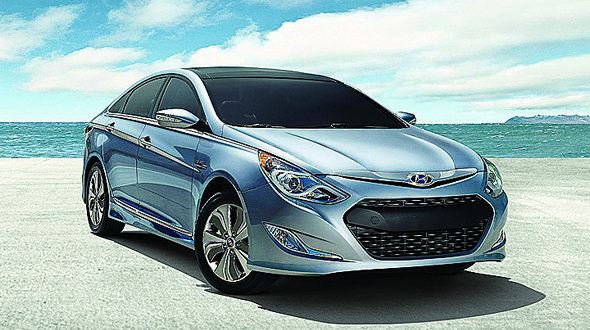
If you’re in the market for a “greener” mode of transportation, check out the 2013 Hyundai Sonata Hybrid. It has an advanced version of Hyundai’s Hybrid Blue Drive system that increases fuel efficiency and operates in the all-electric mode more often and for a longer time.
The improved system optimizes electriconly driving with a higher output 35kw electric motor, a more powerful 47 kW Lithium Polymer battery pack and an optimized hybrid operating strategy. These upgrades are paired with a 2.4-liter fourcylinder engine that now runs on a more efficient Atkinson cycle and an enhanced transmission to generate 199 hp.
The new Blue Drive system delivers better fuel efficiency by increasing the overall available electric drive power to allow more miles between fill ups. As in previous Sonata Hybrids, the new version uses a clutch to decouple the gasoline engine from the drivetrain. In pure electric drive, it has a not-to-shabby top speed of 75 mph.
Hyundai engineers have increased the overall amount of available electrical drive power and improved the efficiency of the Hybrid Blue Drive operating system in this latest Sonata Hybrid. Using a higher output 35kw electric motor and the more powerful 47kw Lithium Polymer battery pack, the Hybrid Blue Drive powertrain maximizes electric-only driving.
The improved operating system takes advantage of newly developed driving pattern detection and engine on/off optimization logic. The availability of more battery energy allows for more flexibility in running the gasoline engine at optimum efficiency, which saves gas. Better kinetic energy recovery and increased charging efficiency powers the Sonata Hybrid in the all-electric mode more often and for longer periods of time, thus increasing fuel economy. Interestingly, the Sonata Hybrid’s new 47kw lithium polymer battery pack not only is more powerful and more energy dense, it also weighs less and takes up less space in the trunk. The weight has dropped from 96 pounds to 91 pounds, while trunk space has increased from 10.7 cubic feet to 12.1 cubic feet.
The improved efficiency of the battery pack is key to recovering more kinetic energy from braking and charging from the engine to help drive the vehicle. The newly optimized system allows the battery to store more usable energy, allowing more all-electric driving, cutting both fuel consumption and emissions.
The 2013 Sonata Hybrid design is basically unchanged, except for re-shaped front and rear fascias with a deeper air dam, extended rocker panels and lower drag wheels that allow air to flow around the body with less resistance.
The base price on the 2013 Hyundai Sonata Hybrid is $25,650.
Ron Beasley is the automotive editor for Miami’s Community Newspapers. He may be contacted by calling 305-662-2277, ext. 261, or by addressing email correspondence to LetsTalkCars@aol.com






